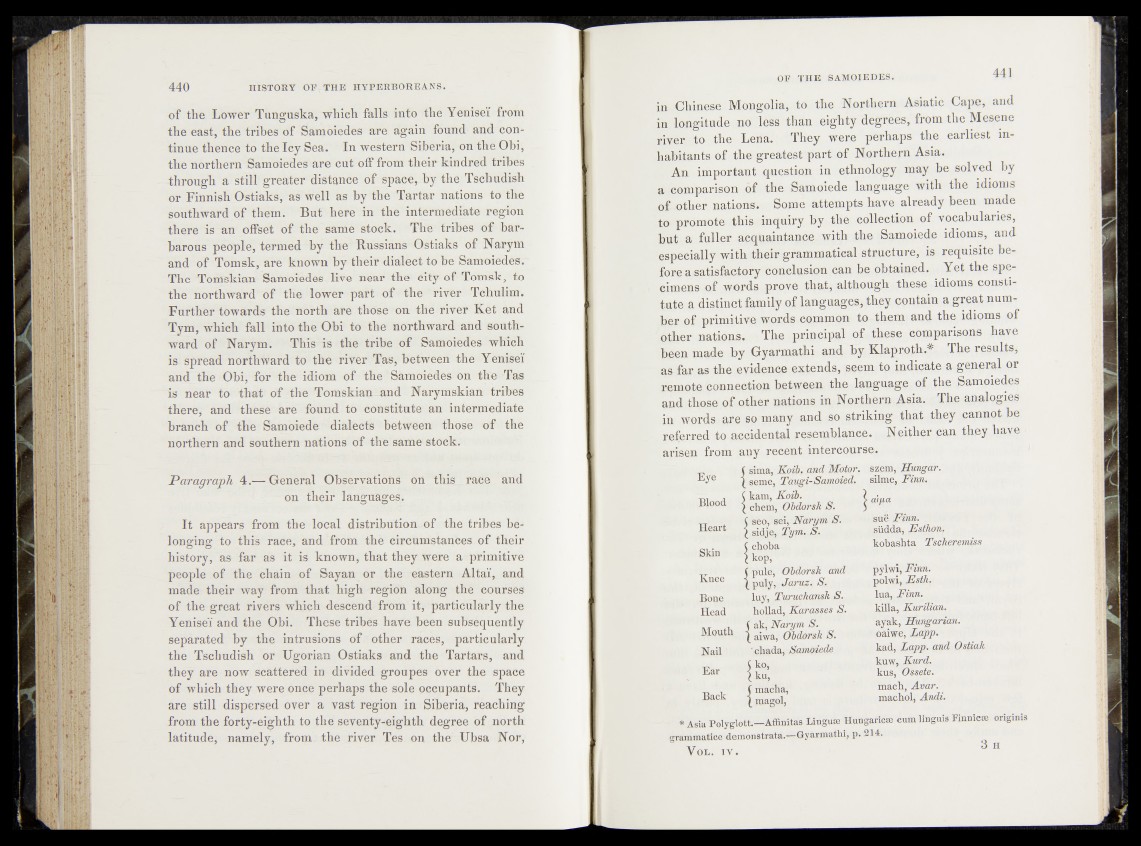
of the Lower Tunguska, which falls into the Yenisei from
the east, the tribes of Samoiedes are again found and continu
® thence to the Icy Sea. In western Siberia,-on the Obi,
the northern Samoiedes‘are cut off from their"kindred tribes
through a stiÉ greater distance of space, by the Tschudish
or Finnish Ostiaks, as well as by the Tartar nations to the
southward of them. But here in the intermediate region
there is an offset of the same stock. The tribes of barbarous
people, termed by the'Russians Ostiaks off Narym
and of Tomsk, are known by their dMèet to be Samoiedesr
The Tomskian Samoiedes Jive near the; city of Tomsk, to
the northward of the lower part of the river Tchulim.
Further towards the north are those on the river Kèt and
Tym, which fall into the Obi to the northward and southward
of Nary in. Thisds the tribe of Samoiédbslwhich
is spread northward to the river Tas, between the Yenisei'
and the Obi, for the idiom of t h é Samoiedes on th é -Tas
is near to that of the Tomskian-and Narymskian tribes
there, and these are found to constitute an intermediate
branch of the Samoiede' dialects between those of tftfe
northern and southern nations of the same stock.
Paragraph 4.— General Observations on thjs_ raöè and
on their languages.
It appears from the local distributiom-of the tribes hé-
long-ingr to this race, and from the circumstances of their
history, as- far as it is known, that they were a-primitive
people of the chain of Sayan or the eastern Altai', and
made their way from that high region along the courses
of thé great rivers which descend from it, particularly the
Yenisei and the Obi. These tribes have been subsequently
separated by the intrusions of other races, particularly
the Tschudish or Ugorian Ostiaks and the Tartars, and
they are now scattered in divided groupes over the space
of which they were once perhaps the sole occupants. They
are still dispersed over a vast region in Siberia, reaching
from the forty-eighth to the seventy-eighth degree of north
latitude, namely, from; the river Tes on the Ubsa Nor,
in Chinese Mongolia, to the Northern Asiatic Cape, and
in longitude no less than eighty degrees, from the Mesene
river to the Lena. They were perhaps the earliest inhabitants
of the greatest part of Northern Asia.
An important question in ethnology may be solved by
a comparison of the Samoiede language with the idioms
offother nations. Some attempts have already been made
to promote this inquiry by the,: collection of vocabularies,
but a fuller acquaintance w^h the ^Samoiede idioms, and
especially with their grammatical structure, is requisite before
a satisfactory conclusion can be obtained. Yet the specimens
of words prove that, although these idioms constitute
a distinct famijjy.of languages, they contain a great number
of primitive, words common to them and the idioms of
other nations. The principal of thfse- comparisons have
been made by Gyarmathi and by Klaproth.* The results,
US-far as the evidence extends, indicate a general or
remote (connection between the language of the Samoiedes
and those of other nations in J^oithorni^sja. The analogies
in-words are so many and so,striking that they: cannot he
referred ,to accidental resemblance, ^either can they have
arisen from any recent., intercourse.
Eye
Blood
Heart
Skin
Knee
Bone,
Head
Idputh
Nail
Ear
Back
f sima, Koib, and Motor. sjzpjn, Jlungar.
(/seme, Tavgi-Samoied. silme, Finn.
( kam, Koib. . , ■ <
( chem, Obdorsh S. | cüjia
( seo, sei, Narym S. Fyhv- 3
1 sidje, Tym. S. S.südda, JEsthon.
( choba
c ko|»>rt ^
kobashta Tscheremiss
f ptile, Obdorsh and pylwi, Finn.
t pnly, Jaruz. H I polwij J^s/A. m
u}^fyLSVWhamh agjjfijgj lua, Finn.
hoUad, Karasses :<§L killa, Kurilian.
( &ls.,NarymS. i ayhk, Hungarian.
( aiwa, Obdorsh 8. I f oaiwe, Lapp-
'cbada, $aw9&de bad, Lapp, ayd Osfiak
C ko. knw, Kurd. j Mm
\ kuy ' fïkns’, Ossete.
( macba, mach, Avar.
\ magql, meitcbolj Andi.
* Asia Polyglott.—Affinitas Lingua* Hangaric®
•grammatice -demonstrate.—Gyarmathi, p. 214.
VOL. TV.
Cum Unguis Finnic® originis
3 H